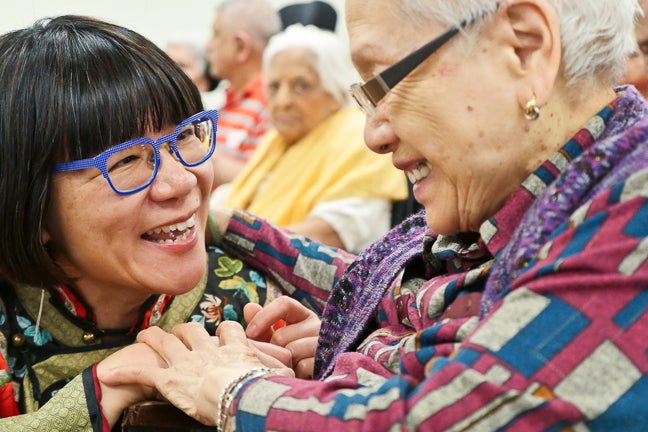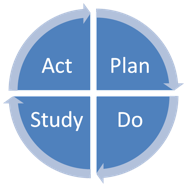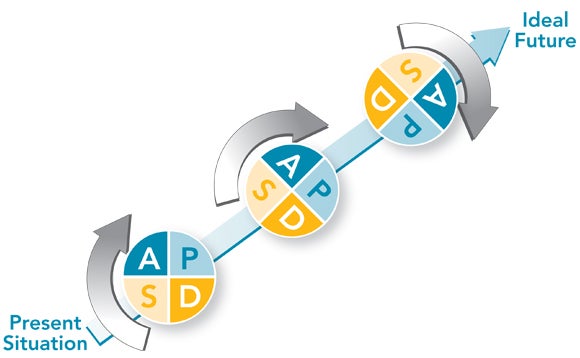
Yee Hong Centre for Geriatric Care. The Executive Director and a resident share a special moment.
Photo copyright Cathy Greenblat, 2014
- What is Delivery?
- What is the purpose of the Delivery phase?
- Before you begin, review your Design Plan
- Measuring results
- Communication is key
- Making adjustments as you go (PDSA cycles)
- Making sure things get done
- Keeping things positive
- References
- Tools and resources for Delivery
What is Delivery?
Delivery is the fifth phase of the Partnerships in Dementia (PiDC) Alliance Appreciative Inquiry process. During Delivery, members work together to carry out the plan created in the Design phase.
It’s important to note that it’s not necessary to wait until the Delivery phase to make changes. In fact, during an earlier phase, you may have identified an opportunity for quick improvement and already acted upon it. If so, that’s terrific. Just be sure to document and celebrate these small changes along the way. It will help to keep people engaged and sustain the appetite for further changes down the road.
For a brief overview of the Delivery phase please refer to our
Delivery fact sheet (pdf)
What is the purpose of the Delivery phase?
The purpose of Delivery is to:
- begin to make the group’s or organization’s aspiration statements a reality
- carry out the plan created in the Design phase
- continue to gather feedback and engage people in the process
- come up with creative solutions to challenges that weren’t identified in the Design Plan
- make adjustments to the Design Plan as necessary
- introduce changes to practice and make them part of the new normal
- support and mentor people within the group or organization as they attempt to carry out action steps
- provide resources needed to carry out action steps
Before you begin, review your Design Plan
Changing the way we do things – including the way we relate to one another – is often harder than we think. Simply asking people to change their practice isn’t enough, even if they support the reasoning behind the change. We need to model the new practice. We need to give others opportunities to practice and give them thoughtful feedback. And we need to applaud their successes. This all takes time. Before carrying out the Design plan, consider revisiting your timelines to make sure you’ve taken all this into account.
While you’re reviewing your Design Plan, make sure that you’ve involved everyone you need to for each goal in the plan. If you’re changing a process, everyone involved in that process will need to understand the change that’s being made and how that affects his or her role. If you’re expecting staff members or volunteers to change the way they do things, be sure their managers are on board. Once again, it’s easy to underestimate the time and effort that needs to go into this. Adjust your timelines if necessary.
Measuring results
Before moving from plan to action, make sure that you understand what success looks like. For each of the goals in your Design Plan, identify how you will know whether you’re making a positive difference in people’s lives. Do this not only for the people your organization serves, but also for family members, staff, and volunteers. Ask yourself how you’ll know whether a change has actually happened.
The Partnerships in Dementia Care Alliance has identified Seven Dimensions of Quality Care that are consistent with relational living. You can use these dimensions to rate your progress.
Caring experiences are at their best when…
- there are nurturing, reciprocal and meaningful relationships.
- everyone feels valued, appreciated and recognized.
- there is flexible, consistent, life-affirming care that considers the values and preferences of all individuals.
- there are meaningful, inclusive and engaging activities.
- living spaces and environments are safe, accessible, and feel/are like home.
- there is humour, laughter and fun. This is true for older persons, family members and staff.
- there is education, knowledge and support.
Here are some other outcomes achieved by organizations that have embarked on culture change:
Better clinical / medical outcomes
- decreased use of antipsychotic and antidepressant medication
- decreased pressure ulcer development
- improved psychosocial outcomes
Enhanced care experiences for older adults, family members and staff
- greater resident/client, family, and staff satisfaction
- a more positive, creative approach to solving problems
- better communication and teamwork
- a better living and working environment
- a shift of focus from care tasks to caring relationships
Better workplace outcomes
- decreased staff absenteeism
- improved staff retention
Changes in outcomes come as the result of changes in processes (such as consistently assigning the same staff to individuals). Shifts in your organization’s culture may occur gradually as the result of a series of small changes. Starting small is often an effective strategy.
Communication is key
As you move from plan to action, it’s critical that people know what they’re supposed to do. You’ll need to communicate this as clearly and concisely as possible. Here are a few key points you’ll likely want to cover:
- what you’re asking them to do (keep it simple and specific)
- when you’re asking them to do it
- why what you’re asking them to do is important (link to an aspiration statement)
- where they can go with questions or concerns
You’ll likely need to customize your messages for different audiences. What you tell a family member may differ from what you tell a staff member, partly because their roles in the action plan may be quite different. You also may need to customize the way you communicate. Face-to-face communication is often best, but it’s also time-consuming, particularly if you have a lot of people to talk to and you try to do it all yourself. Consider enlisting the help of different people within your group or organization to help spread the word. Use other forms of communication to reinforce your message (e.g. emails, conference calls, posters, displays, etc.).
Make sure that messaging is consistent across all levels of your organization. Although it’s important to have managers in your organization on board, don’t rely too heavily on traditional top-down channels. Often peer-to-peer communication can be effective, particularly if the message is coming from someone who’s been part of the culture change coalition or has otherwise played a role in the culture change process.
Remember that communication is a two-way street. Continue to provide opportunities for feedback. Remain open to suggestions about how changes can be made.
Don’t assume that just because a message has been delivered that it’s been received. Often people need to hear something several times for it to sink in, particularly if they’re busy. It’s more likely to stick if they can immediately see how it helps them solve a problem that’s important to them. They’ll likely also be more receptive if you’ve included them in the culture process in earlier phases and they feel that they’ve been heard.
Keeping everyone on the same page is something that can take a lot more time than expected, but it’s essential for avoiding confusion and frustration.
Making adjustments as you go
Although a lot goes into creating a Design Plan, as much effort if not more needs to go into carrying it out. An effective Design Plan lays out the steps for your group or organization to follow, but as you take these steps, you’ll inevitably come up against challenges you didn’t anticipate. You may need to make adjustments to your original plan, while staying true to your organization’s or group’s aspiration statements.
Plan-Do-Study-Act (PDSA) cycles are a method of making small rapid changes, quickly evaluating them, making adjustments, and then starting the process all over again.
- Plan - develop a plan to test the change
- Do – carry out the test
- Study – observe and learn from the consequences
- Act – determine what modifications should be made to the test
(Adapted from the Institute for Healthcare Improvement)

Image retrieved from: NHS Wales www.iqt.wales.nhs.uk
The Study step prompts you to reflect on whether your plan worked as you’d hoped. It also encourages you to look at what happened when the plan was put in action. Based on what you learn, you may revise your plan, take slightly different actions (if necessary), and then see if the outcome is different.
The PDSA approach of going through several, consecutive rapid change cycles reduces the risk of getting to the end of a project only to find it wasn’t successful because an obstacle that came up early on wasn’t addressed promptly.

Image retrieved from: Georgia Pediatric Subspecialists - http://www.gpsipa.com/quality/the-pdsa-cycles/
It’s important to ask two overarching questions:
- Is the change an improvement?
- Is the change consistent with relational caring and culture change values?
A change that looks good on paper doesn’t always work in real life. There may be unintended consequences that crop up only once you carry out your plan. Having a clear set of success indicators for each goal in advance will help you answer this question.
PDSA cycles will help to flag concerns early. That being said, don’t be too quick to abandon your plans if things get a little bit “bumpy” to start out. Consider whether it’s simply an implementation problem as opposed to a problem with your plan.
Making sure things get done
Having an action plan is no guarantee that people will follow it. There may be several reasons why people don’t follow through on actions they’ve committed to. The table below uses the Influencer change management framework to identify different reasons people may not follow through. The next table uses the same framework to suggest what you can do about it.
| Motivation | Ability | |
|---|---|---|
| Personal | They don’t really want to do it. | They don’t have the knowledge, skills, and strengths to do it. |
| Social | They’re not being sufficiently encouraged by people around them. Or they’re actively being discouraged. | They’re not receiving the necessary help, information, and resources from others |
| Structural | They’re not being rewarded for doing it (e.g. recognition, positive feedback, perks, celebrations, career advancement, etc.). Or the costs are too great for them (e.g. time, energy, hassle). | Their environment isn’t set up for them to succeed. They don’t have the necessary tools or information. They’re not located close enough to others. Organizational practices and policies don’t enable them to act. |
Adapted from Influencer: The New Science of Leading Change www.vitalsmarts.com
It’s likely that a number of these factors are in play at the same time. According to the “Influencer” change management model, the more factors you can address, the more likely you’ll be able to support individual and organizational change.
| Motivation | Ability | |
|---|---|---|
| Personal |
Make the undesirable desirable
|
Help people surpass their limits
|
| Social |
Harness peer pressure
|
Find strength in numbers
|
| Structural |
Design rewards and hold each other accountable
|
Change the environment, practices, and/or policies
|
Adapted from Influencer: The New Science of Leading Change www.vitalsmarts.com
Keeping things positive
Remember to keep following the principles of Authentic Partnerships and Appreciative Inquiry as you carry out your plan. Also, create opportunities to celebrate success. It will help everyone involved see that they’re making progress.
References
Dupuis, S.L., McAiney, C.A., Fortune, D. B., Ploeg, J., & de Witt, L. (2014). Theoretical foundations guiding culture change: The work of the Partnerships in Dementia Care Alliance. Dementia Online First, January 13, 2014. Available from Sage Journals Online
Grenny J., Patterson K., Maxfield D., McMillan R., & Switzler A. (2013). Influencer: The New Science of Leading Change. (2nd ed.). Retrieved from www.vitalsmarts.com
Hammond, S. A. (1998). The thin book of appreciative inquiry. 2nd ed. Thin Book Publishing Company: Bend, OR.
Institute for Healthcare Improvement. (2016). How to improve. Retrieved from http://www.ihi.org/resources/Pages/HowtoImprove/default.aspx
Tools and resources for Delivery
Delivery fact sheet (pdf)
Seven Dimensions of Quality Care (pdf)
Is your organization experiencing challenges with the Delivery phase?
For assistance with overcoming culture change barriers see our guide to overcoming barriers to culture change.